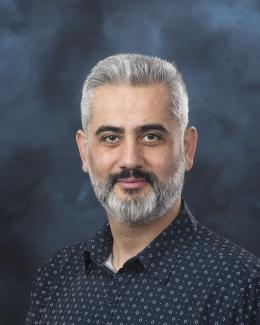ORNL Composites Innovation staff members David Nuttall, left, and Vipin Kumar use additive manufacturing compression molding to produce a composite-based finished part in minutes. AMCM technology could accelerate decarbonization of the automobile and aerospace industries. Credit: ORNL, U.S. Dept. of Energy
Researchers at the Department of Energy’s Oak Ridge National Laboratory are extending the boundaries of composite-based materials used in additive manufacturing, or AM. ORNL is working with industrial partners who are exploring AM, also known as 3D printing, as a path to higher production levels and fewer supply chain interruptions.
Composites – materials derived by combining two or more materials, such as wood, plastics, carbon fiber, ceramics, glass, metals and concrete – are being additively manufactured into lightweight, energy-efficient parts for an increasing number of automotive, aerospace, construction and other industrial and consumer uses. Some composite materials are even specially formulated to withstand the extreme temperatures of space.
The increased use of AM for ever-widening applications is creating demand for faster manufacturing rates and new composites that are stronger, lighter and more resilient.
Vlastimil Kunc, Composites Science and Technology section leader at ORNL, said AM and materials research conducted at DOE’s Manufacturing Demonstration Facility and Carbon Fiber Technology Facility enhance the manufacturing capabilities of AM operators in the United States. “ORNL has the only facilities in the country with a full ability to formulate, create, print and recycle composite materials.”
“The ability to go from raw materials to finished part and back to composite ingredients in a ‘cradle to cradle’ approach provides a complete lifespan view of composites. This method helps us to identify and develop the right sustainable-material feedstock and processes for unique 3D-print applications,” he said.
ORNL scientists are concentrating on growing digital tooling to automate time-consuming and labor-intensive process steps throughout the lifecycle process. This focus will help the AM industry to better meet demand for higher production rates and shorter new-product lead times. They are directing their efforts on four areas of composite materials science:
- Advancing materials and techniques for large-scale manufacturing. Scientists are working with industry and university partners to develop innovations such as low-cost precursors and energy-efficient manufacturing processes. One partnership resulted in ORNL and University of Maine researchers creating the nation’s first additively manufactured home made entirely from biobased materials. The polyactic acid, or PLA, material used in BioHome3D is a biologically derived and biodegradable thermoplastic polyester made from a mixture of 20% bamboo and 80% PLA. The properties of the printed home, including recyclability, are similar to those built with traditional wood construction. This means that if the home is torn down, the materials could be reused again and again to make parts for other products.
- Evolving composites for faster production. New composite formulations and improved AM processes are helping to drive increased throughput and energy efficiency for U.S. manufacturers. The ORNL-developed additive manufacturing compression molding, or AMCM, technology enables rapid production of composites-based components that could accelerate ground vehicle and aerospace decarbonization efforts. This advanced manufacturing process uses short-fiber-filled polymer and continuous fiber to print directly onto a mold with precise orientation to make parts, such as propellor blades or battery boxes. Compression molding then turns the printed components into an accurate finished piece. AMCM has been proven to significantly reduce manufacturing time and cost, with researchers producing 100 parts in five hours at an average print rate of less than three minutes for each piece.
- Creating materials for extreme environments. Developing and testing carbon-carbon and ceramic composite materials for demanding applications, such as space travel or nuclear reactors, is critical for shielding people and equipment against extreme heat, radiation or plasma. Working with a team from NASA, ORNL researchers developed materials that can withstand extreme reentry temperatures and used them to 3D print a thermal protection shield. The TPS protected a space capsule, developed by the University of Kentucky to test entry system technologies, as part of a supply mission to the International Space Station. The launch marked the first time an additively manufactured TPS was sent into space.
- Advancing sustainable manufacturing. An end-of-service “circular economy” that reuses recyclable and cost-competitive materials multiple times will help decarbonize and reinforce the composites supply chain. A team of researchers from ORNL and Airtech International showed the possibilities of such a repurposing process at this year’s Pike’s Peak International Hill Climb. The team contributed to a record-setting race-car performance by recovering expensive, hard-to-recycle thermoplastic material from a 3D-printed large-format additively manufactured (LFAM) mold. The material was then used to create the world’s first 100% recycled, 3D-printed LFAM aerodynamic splitter mold at a fraction of the cost and environmental impact of traditional approaches. The splitter made from the mold increased downforce on the car to improve handling on sharp and steep turns at more than 140 miles per hour to set a new world speed record in its class.
ORNL develops carbon-fiber material with a focus on structural properties and process optimization at the Carbon Fiber Technology Facility. As DOE’s only designated user facility for carbon fiber innovation, the CFTF supports the technology development and commercial deployment of carbon fiber for use in clean energy applications in the United States. AM and materials research is conducted at the Manufacturing Demonstration Facility to encompass the entire composite supply chain in a wide range of end-use applications. The MDF, supported by DOE’s Advanced Materials and Manufacturing Technologies Office, is a nationwide consortium of collaborators working with ORNL to innovate, inspire, and catalyze the transformation of U.S. manufacturing. Information on how industries can work with ORNL is available at www.ornl.gov/partnerships.
UT-Battelle manages ORNL for DOE’s Office of Science, the single largest supporter of basic research in the physical sciences in the United States. DOE’s Office of Science is working to address some of the most pressing challenges of our time. For more information, visit https://energy.gov/science.





